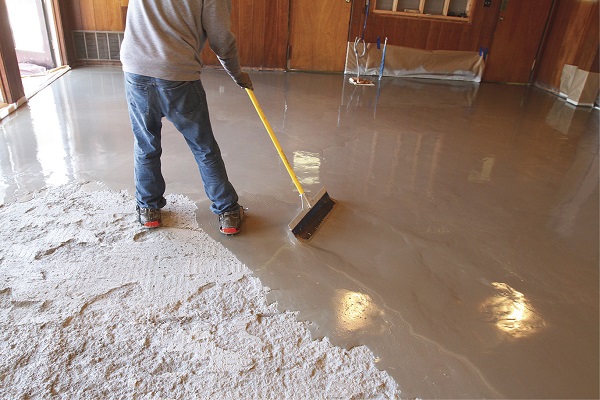Self-leveling concrete can be a quick and cost-effective solution whenever you need to repair, smooth, or raise a floor.
Floor self-leveling is a cementations mixture similar to concrete. But unlike concrete, it flows more easily and settles much faster. The product is mixed with water, pumped or poured onto the site, and spread evenly using a gauge. Once spread, it continues to flow evenly and level out.
Depending on the product, it can be smooth and flat within 1-2 hours. It can be completely cured and ready for use in approximately 6 hours, depending on the floor material being installed over it.
self-leveling concrete
Now let’s clear up some things about product names. Instead of “concrete”, you may come across products called “self-leveling screed”. This name means the same as “self-leveling concrete flooring”.
They are generally mixtures of Portland cement, polymer plasticizers, and other additives. They have the strength of concrete, but flow more easily and build quickly.
Self-leveling flooring can be poured as thin as a quarter inch, just enough to smooth out small imperfections if that’s all you need. However, if the concrete floor has low spots and needs to be smoothed out, even more, it can be poured to a thickness of one and a half inches without aggregate and 5 inches with aggregate (making sure to follow all manufacturer’s instructions).
Self-leveling floor works particularly well in radiant heating installations because it flows easily around the pipes. Stronger leveling compounds for floors, which have to be troweled to achieve the correct surface, cannot do this.
If you find that moisture is a problem in your board, you need to call in a professional to handle the moisture remediation. You can also visit the International Concrete Repair Institute (ICRI) for more information on the next steps or find an expert to help you.
Where self-leveling flooring is used
Let’s say you’re upgrading an old, damaged floor that’s settled or cracked. Or perhaps you are installing a radiant heating system on the floor. Maybe you’re building an extension and need to match the floor to the floor in the next room. Perhaps you are finishing a basement where the floor is rough and uneven concrete.
Other concrete cladding applications include warehouse floors, light industrial applications, retail stores, and institutional facilities. Concrete surfaces can also receive pigmented color dyes, stains, saw cuts, or mechanical polishing to create a decorative concrete finish surface.
Preparation for the use of self-leveling compound
Before installing your new floor, there is one crucial thing to consider: the moisture in the existing concrete floor. All self-leaving concrete contains moisture, and if the moisture level is too high, it can cause the leveling compound to degrade over time. So you need to test the board to make sure the moisture level is not too high.
This is not something you can do just by looking at the board. No matter what the board looks like, moisture deep in the board can migrate to the surface over time and cause serious problems. If the moisture level deep in the slab is too high, you must take steps to correct it before you can pour a new concrete floor.
This is a known problem with a known and scientifically proven solution. The way moisture moves within a concrete slab have been studied since the 1960s, and researchers have developed a scientifically proven test to measure moisture levels deep inside the slab. This test is called the “in situ probe relative humidity test”.

0 responses to “Floor self-leveling secrets you don’t know before ”